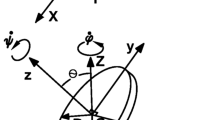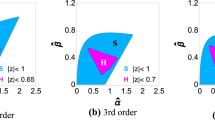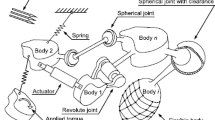Abstract
Determining states of static equilibrium for multi-body-dynamic (MBD) systems can be challenging and may result in convergence failure for nonlinear static solvers. Analysts are often faced with uncertainty in regards to the values of candidate equilibrium states or whether a state of minimum potential energy was found. In the event of static solver failure or uncertainty with regards to a candidate solution, equilibrium could be obtained through a dynamic simulation which may require the addition of artificial damping. However, this method can have significant computational expense as compared to static solution procedures. Using MBD systems representing a pendulum, two variations of a spring supported arch, and a seven-body mechanism, arc-length solvers were found suitable for identifying equilibrium states through a robust production of static solution curves thereby avoiding dynamic simulation. Using these examples, a procedure for finding the correct equilibrium state for general systems is proposed.
































Similar content being viewed by others
References
Rose, G., Nguyen, D., Newman, B.: Implementing an arc-length method for a robust approach in solving systems of nonlinear equations. In: IEEE Southeast Conference (2016)
Wempner, G.A.: Discrete approximations related to nonlinear theories of solids. Int. J. Solids Struct. 7, 1581–1599 (1971)
Riks, E.: An incremental approach to the solution of snapping and buckling problems. Int. J. Solids Struct. 15, 529–551 (1979)
Crisfield, M.A.: A fast incremental/iterative solution procedure that handles snap-through. Comput. Struct. 13, 55–62 (1981)
Meirovitch, L.: Methods of Analytical Dynamics. Dover, New York (2003)
Negrut, D., Dyer, A.: ADAMS/Solver Primer. MSC Software Corporation, Santa Ana (2004)
Nastran Nonlinear User’s Guide. SOL 400, MSC Software Corporation (2016)
Abaqus Analysis Users Guide. Dassault Systèmes Simulia Corp. (2014)
Allgower, E.L., Georg, K.: Numerical path following. In: Handbook of Numerical Analysis, Vol. V. Techniques of Scientific Computing (Part 2), pp. 3–207. Elsevier, Amsterdam (1997)
Allgower, E.L., Georg, K.: Numerical Continuation Methods: An Introduction. Springer Series in Computational Mathematics, vol. 13. Springer, Berlin (1990)
Nonlinear finite element methods, course notes for ASEN 6107, http://www.colorado.edu/engineering/cas/courses.d/NFEM.d/Home.html, accessed 3 March 2017
About ADAMS/Solver. C++ Statements, MSC Software Corporation (2016)
Bathe, K.J.: Finite Element Procedures. Klaus-Jürgen Bathe (2006)
Rose, G., Nguyen, D., Newman, B.: Parallel Computation of the Jacobian Matrix for Nonlinear Equation Solvers Using MATLAB. NASA/TM-2017-219655 (2017)
Schiehlen, W. (ed.): Multibody Systems Handbook. Springer, Berlin (1990)
MapleSim User’s Guide. MapleSoft, Waterloo Maple Inc. (2017)
MapleSim Model Gallery, https://fr.maplesoft.com/products/maplesim/ModelGallery/Index.aspx, accessed 21 December 2017
De Borst, R., Crisfield, M.A., Remmers, J.J.C., Verhoosel, C.V.: Non-linear Finite Element Analysis of Solids and Structures, 2nd edn. Wiley, New York (2012)
Ramm, E.: Strategies for tracing the nonlinear response near limit points. In: Proceedings of the Europe–U.S. Workshop on Nonlinear Finite Element Analysis in Structural Mechanics (1981)
Ascher, U.M., Petzold, L.R.: Computer Methods for Ordinary Differential Equations and Differential-Algebraic Equations. SIAM, Philadelphia (1998)
Meirovitch, L.: Fundamentals of Vibrations. McGraw-Hill, New York (2001)
Menrath, M.: Stability Criteria for Nonlinear Fully Implicit Differential-Algebraic Systems. University in Cologne, Germany (2011)
Shabana, A.: Computational Dynamics, 3rd edn. Wiley, New York (2010)
Bader, B.W.: Tensor-Krylov methods for solving large-scale systems of nonlinear equations, in: Sandia Report SAND2004-1837 (2004)
MATLAB R2015b Documentation. The MathWorks, Inc. (2015)
Negrut, D., Ortiz, J.: On an approach for the linearization of the differential algebraic equations of multibody dynamics. In: Proceedings of the ASME/IEEE International Conference on Mechatronic and Embedded Systems and Applications (2005)
Modelica®—A Unified Object-Oriented Language for Systems Modeling, Language Specification, Version 3.4. Modelica Association (2017)
Maple User Manual. MapleSoft, Waterloo Maple Inc. (2017)
Acknowledgements
This work was funded by the Advanced Degree Program at NASA Langley Research Center.
Author information
Authors and Affiliations
Corresponding author
Rights and permissions
About this article
Cite this article
Rose, G.K., Newman, B.A. & Nguyen, D.T. A path following method for identifying static equilibrium in multi-body-dynamic systems. Multibody Syst Dyn 45, 315–359 (2019). https://doi.org/10.1007/s11044-018-9618-7
Received:
Accepted:
Published:
Issue Date:
DOI: https://doi.org/10.1007/s11044-018-9618-7




